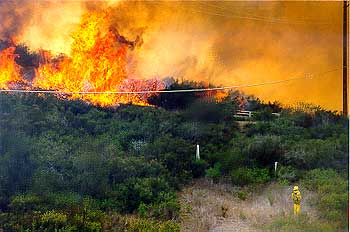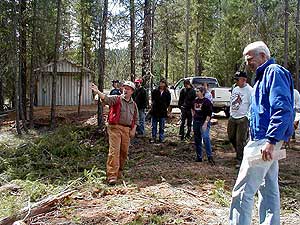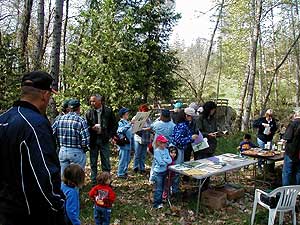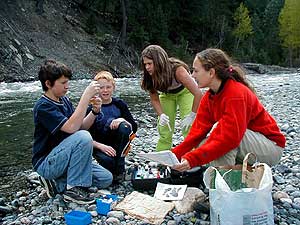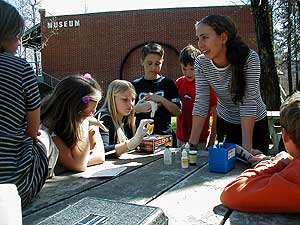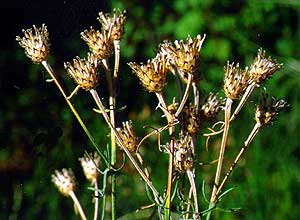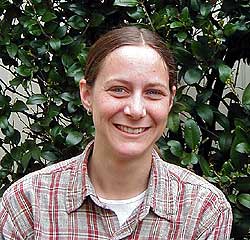
|
|

|
|
In This Issue:
State Water Resources Control Board, Ca. Dept. of Fish & Game, and the Dept. of Conservation
Trinity River Restoration Program -
|
|||||||||||||||||||||||||
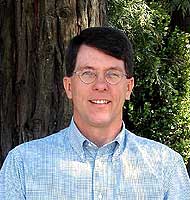
In many ways, being selected by the Bureau of Reclamation as Executive Director for the Trinity River Restoration Program in October 2001 was a homecoming of sorts for Doug Schleusner. Born in Yreka, he lived in Fort Jones where his father taught high school in early 1950s. Later on, Doug lived in Redding for most of the 1980s, where he worked on the Shasta-Trinity National Forests, and met his wife, Sandra. Their children, Eric (9th grade) and Katherine (7th grade) were also born in Redding. Doug received his Bachelor of Landscape Architecture from the University of Idaho in 1976, and his Master of Regional Planning from the University of Massachusetts in 1978. From there he started his 23-year career with the Forest Service on the Tongass National Forest in Southeast Alaska – which is where he developed a real love for boating and salmon fishing. During his federal government career he has also worked in northern New Mexico and in the Washington DC headquarters of the Forest Service. Doug’s experience includes recreation management, program development and budgeting, land use planning, and natural resource management, with a special interest in watershed conservation and river-related recreation. |
Recent issues of the Trinity Journal have featured a number of articles and public notices related to the Trinity River, including “Judge Orders More Water Flow to River,” Public Meeting on Proposals for Trinity River Bridge Modifications,” and “Notice of Preparation for Supplemental EIS and Recirculated Draft EIR for the Trinity River Mainstem Fishery Restoration Program.” Some of you, who are either new to the area, or those who haven’t been closely following recent events, may be wondering about the recent flurry of activity. These, and other events, are all related to the Record of Decision (ROD) signed by then Secretary of the Interior Bruce Babbitt on December 19, 2000.
To quickly summarize, that decision had five main components:
- higher flows in the Trinity River released from Trinity and Lewiston dams, based on the type of water year (e.g., “critically dry, normal, extremely wet”)
- modification or replacement of four bridges to accommodate the higher flows
- a variety of mechanical restoration activities that would improve quantity and quality of salmon and steelhead habitat within the river channel
- extensive monitoring of the effects of these efforts on fish populations, and
- establishment of an organization to implement all aspects of the Restoration Program.
Supplemental EIS – Shortly after the ROD was signed, a lawsuit was filed by a group of Central Valley water and power users, and Federal District Court Judge Oliver Wanger enjoined the part of the decision that provided increased flows for the Trinity River – capping the maximum release at the level defined for a “critically dry” water year (an increase of 28,600 acre feet above the previous 340,000 acre-feet). A supplemental EIS and recirculated draft EIR is being prepared by the co-lead agencies (Bureau of Reclamation, Fish and Wildlife Service, Hoopa Valley Tribe, and Trinity County) to address the issues raised in the lawsuit. A public scoping meeting was held on May 9, and comments will be received until May 23. Completion of the administrative draft is scheduled for February 2003, with a record of decision in time to implement the flow schedule for the 2004 water year.
Higher Flows – In March of this year, the Hoopa Valley Tribe petitioned Judge Wanger to allow a higher level of flows this coming water year, since it is projected to be “normal” rather than “critically dry.” The recent news articles mentioned earlier described his April 19, 2002 decision, which will allow an additional 100,000 acre-feet to be released during the coming months. Most of you have noticed that the river has been higher, peaking at 6,000 cubic feet per second (cfs) the first week of May. The flows will gradually taper off to about 1,000 cfs by early June, and reach summer flow levels of 450 cfs by late June.
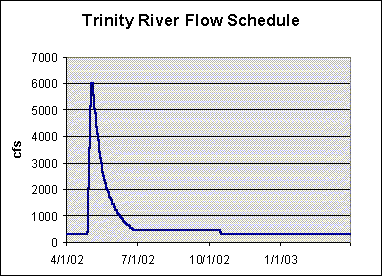
The Judge’s decision specifically allowed elements of the ROD other than the higher flows to proceed, subject to site-specific environmental studies and permits. These activities include planning, design, and construction efforts for four bridges (modification or replacement) and approximately 45 potential restoration activity sites (such as sediment management and channel modification).
Trinity River Bridges – The replacement and/or reconstruction of four bridges (Salt Flat, Poker Bar, Treadwell, and Bucktail) will be necessary to accommodate the higher flows envisioned in the Record of Decision (up to 11,000 cfs in “extremely wet” water years once bridge improvements are completed). A public meeting was held here in Weaverville on May 2, where preliminary alternatives were presented that illustrate issues associated with modifying the existing bridges, replacing one or more of the existing bridges at their current locations, or installing one or more new bridges at different locations.
Channel Rehabilitation Sites –The first group of potential channel rehabilitation sites are now being examined. We are working with a contractor, North State Resources, to identify the scope of work, purpose and need, and the level of detail needed for conceptual designs in the environmental documents. A public meeting will be scheduled later this spring.
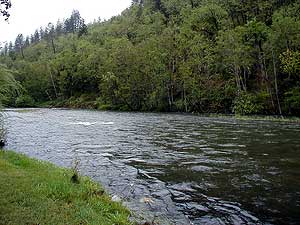 |
In the summer issue of the Conservation Almanac, Doug Schleusner will present the Trinity River Restoration Program Organization, which includes three components, the Trinity Management Council, the Adaptive Environmental Assessment and Management Team (AEAM), and the Trinity Adaptive Management Working Group. Doug will also introduce the members of his immediate staff, the AEAM Team, composed of the Technical Modeling and Analysis Group and the Rehabilitation and Implementation Group. He is now in the recruitment and hiring phase for about 12 positions. He hopes to be fully staffed by this summer. Mr. Schleusner can be reached at (530) 623-5944.
Watershed Coordination ActivitiesThe RCD along with the Post Mountain PUD and Volunteer Fire Department hosted a Fuels Reduction Workshop at the Post Mountain Fire Hall on White Oak Road on April 6th to show landowners how to effectively make property fire safe. Our Registered Professional Forester, Ken Baldwin demonstrated how to do a sample mark of vegetation to be removed, while explaining the reasons for each selection. Workshop participants teamed up and had a chance to do their own sample mark, with feedback from the forester. An overall improved forest health was one of the objectives, along with a more fire safe property. An RCD crew demonstrated tree cutting and falling techniques.
Three proposals have recently been approved for funding additional watershed restoration work in the South Fork Trinty River Watershed. The California Department of Fish and Game, the Trinty County Resource Advisory Committee, and the State Water Resources Control Board will fund road-related erosion control projects on US Forest Service lands. The work will take place in the Upper South Fork Trinity River where Watershed Analysis and National Environmental Policy Act (NEPA) have been completed. The RCD continues to play a central role in coordinating stakeholders interested in the Trinity River Watershed. The District helped form the Trinity River Watershed Working Group earlier this year, and has used this group to help interested parties stay involved in the restoration of the Trinity River. The District just received notice that its proposal to conduct public education and outreach for the Trinity River Restoration Program has been approved by the Bureau of Reclamation. The District was found to be one of the appropriate avenues of disseminating information.
Pat Frost, District Manager, facilitated a public workshop on the raising of 4 bridges to accommodate the higher flows recommended by the Trinity River Fishery Restoration Environmental Impact Statement. Additional work that has recently been approved for funding in the Trinity River Watershed includes a Bureau of Land Management Road Inventory, the Nor-El-Muk Restoration Project at Salt Flat, and a Scotch and French Broom Eradication Project near Junction City. |
Kids in Conservation
The program began last September when the Weaverville Elementary School 6th grade class attended Environmental Education Camp at Bar 717 Ranch near Hyampom. This ongoing program will continue through March 2003 and is designed to teach children about the importance of healthy watersheds for restoring salmon populations.
California Department of Fish and Game
|
| ||
| Students from Coffee Creek Elementary (left) and Weaverville Elementary (right) learn water quality monitoring techniques from Elizabeth Gill. | |||
Trinity High Students Attend Yosemite Institute
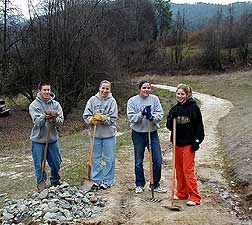 |
Savannah Matyas, Stacy Stanberry, Kalin Nichols, and Nick Cole were interviewed and selected to attend the Yosemite Institute during their spring break along with 150 other North State Students.
Candidates to the Institute were required to log in 10 hours of community service work.
The District quickly found use for the energetic students by providing tools and instruction to address erosion control on the Lee Fong Park trail.
The trail work was not nearly as fun as being in Yosemite, according to Savannah Matyas. “Everyone had a great time, the Institute provided natural resource education, long beautiful hikes, and good evening programs.”
Hayfork High Students Compete at State Envirothon
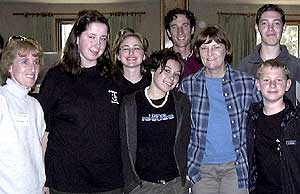 |
Kristina Horn, Matt Johansing, Brandi Miller, Kirsten Newman, and Kelsey Vaughn representing Hayfork’s ‘Earthsense’ Team, came in 4th place at the Introduced Species station.
The Envirothon is a written and hands-on competition of high school students’ knowledge of California’s natural resources. Topics include including soils, forestry, wildlife, aquatics, and a yearly current environmental topic. This years topic was Introduced Species and Their Effect on Biodiversity.
Sponsored by the District, the team prepared for weeks prior to the event, with local resource professionals. “This is a great opportunity for high school students to increase their awareness of important natural resources and to meet other like-minded students from around the state" noted Patrick Frost, District Manager. With only one team member Brandi Miller, scheduled to graduate this spring, we look forward to working with the rest of the team again next year.
Noxious Weeds to Watch in Trinity CountyNew Brochure Now AvailableThe Trinity County Weed Management Cooperative is happy to announce the arrival of the Noxious Weeds to Watch in Trinity County brochure hot off the presses. Look for at it the Trinity County Resource Conservation District, Trinity Resource Conservation and Development Council, and Trinity County Agricultural Department today. The brochure describes noxious weeds of concern in the county, as well as how to deal with these invaders and who to contact if you have a problem on your property. Spotted Knapweed (Centaurea maculosa)Most people living in Trinity County can probably point out yellow star thistle or Himalayan blackberry, two common noxious weeds in our neck of the woods. Some might even be able to identify tree-of-heaven or scotch broom as non-native, invasive plants of concern. Unfortunately, noxious weeds are not always as unpleasant to walk through as star thistle, calling attention to itself. Fortunately, many noxious weeds are not equally prevalent in all places that they occur. Highly invasive weeds that are still fairly uncommon in an area are important targets in weed management activities by federal, state, and county organizations.
Seeds germinate in fall and early spring. Seedlings form rosettes (a dense cluster of leaves at or near the soil surface), which may produce 1-7 flowering stems the following spring. Marked plants in the Glacier National Park area in Montana have been observed to persist in the rosette stage for four years or longer before producing flowering stems. Plants may flower only once, or up to three years in succession, and perennial plants may have up to 20 flowering stems. Seeds remain viable for up to eight years in the soil. Since spotted knapweed has such a limited presence in Trinity County, it is extremely important to notify the Trinity County Agricultural Commissioner at (530)623-1356 or the TCRCD if you suspect it to be on your property. We will be able to offer advice and assistance controlling this important noxious weed. Spotted Knapweed Weed-PullCome join the Trinity County Weed Co-op and your neighbors on Saturday, June 8 at 10:00 am to pull spotted knapweed, a nasty, noxious weed. Meet at the Weaverville Golf Course parking lot. REFRESHMENTS PROVIDED! Help stop the spread . . . |
Community-wide Fuel Reduction
Planning Effort Started
A new effort to assist private landowners plan fuel reduction projects on their property has begun. The Trinity Resource Conservation and Development Council, (Trinity RC&D Council, Inc.) was awarded grant funds from the U.S. Forest Service, National Fire Plan Program to complete a Program Timberland Environmental Impact Report (PTEIR) for a community-wide fuel reduction project. The idea behind the project is to get private property owners to plan fuel reduction projects on their property in conjunction with similar projects on private property throughout their community.
The PTEIR provides the environmental analysis and documentation required by the California Environmental Quality Act (CEQA). A Registered Professional Forester will work with property owners to evaluate resources at risk on their property and will assist with the development of prescriptions that make sense for reducing wildfire risk throughout the community. Property owners who participate in the planning process will be able to file the equivalent of a Timber Harvest Plan (THP) for fuel reduction activities, and therefore can legally barter or sell the logs and bio-mass generated by the project.
Kenneth Baldwin and Associates has been contracted to complete the PTEIR and assist private property owners within the project boundary. The Trinity County Resource Conservation District, the Watershed Research and Training Center, the California Department of Forestry and Fire Protection, and other members of the Trinity County Fire Safe Council are providing guidance on where the project should be implemented.
For additional information on this project contact Scott Eberly, Trinity RC&D Council, Inc., at 530-623-2009 or Kenneth Baldwin at 530-623-3208.
Return to this Issue's IndexDistrict Manager's Corner
by Pat Frost
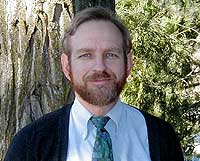 |
Good stewardship begins with good communication. We need to be able to talk with one another about the ways we manage land and water resources. The Natural Resources Conservation Service (NRCS) has a wealth of technical information to share. Jim Spear, the District Conservationist, and his staff have the know-how to help you with a wide range of soil and water conservation issues – you just have to ask.
I have been impressed with the spirit of cooperation that exists in Trinity County. The Trinity County Fire Safe Council is a great example. A wide range of interests; from the Volunteer Fire Chiefs to the Association of Realtors, meet every month to work towards common goals – reducing the risk of severe wildfires and improving the health of our forests.
We are all connected to one another. Our streams and forests link us together in many ways, providing jobs and recreation. We share sources of drinking water with boaters and fishermen. We work, hunt and hike throughout our forests. This web of interaction is community. Our collective fate is tied to the health of our streams, lakes and forests.
There actually is a fourth “C” that reminds me why it is so important for our community to keep talking about resource issues and cooperating with each other – children. They are Trinity County’s future. And as the photo feature “Kids in Conservation” shows, our children understand the Three C’s of conservation.
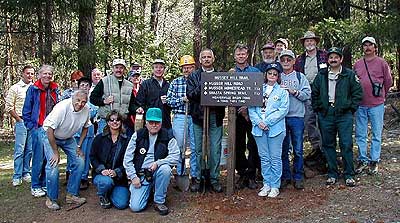 |
New Soils Conservationist at Natural Resource Conservation Service
|
Return to the Trinity County RCD Home Page


